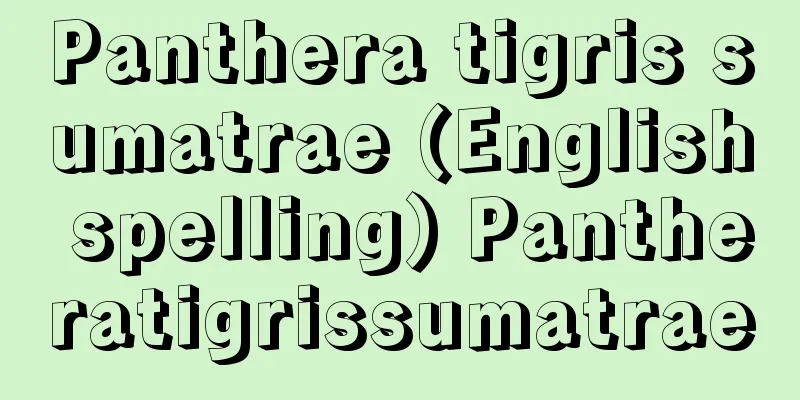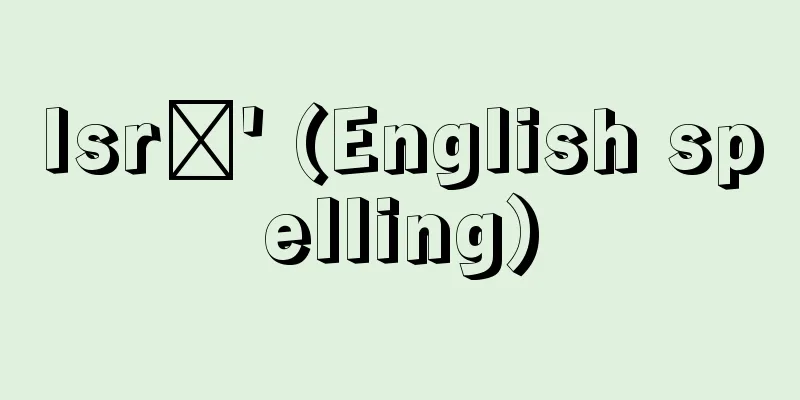Sleeve - Sleeve

|
Originally it was called "sode" or "sode". It refers to the part of the garment that is on the outside of the body and covers the arm, and is also called "tamoto". "Tamoto" originally comes from "tamoto" (hand). The character for "sode" comes from "nuku" (to pass through), meaning the part of the garment through which the hand passes, and "ketsu" (sleeve) comes from "open", meaning the opening of the garment. In Western clothing terms it is called a "sleeve". [Akira Ishiyama] Types of kimono sleeves(1) Nagasode Also called "sleeve sleeves", these sleeves have a sewn cuff, as opposed to wide sleeves or tube sleeves. In the broad sense, this term includes long sleeves such as furisode, but in the narrow sense, it usually refers to women's sleeves with a length of around 50 cm. For young women and formal kimonos such as Homongi, the sleeves are 5 to 10 cm longer. (2) Furisode O-furisode is for brides and has a sleeve length of around 115 cm. Chu-furisode is around 105 cm, Ko-furisode is around 85 cm, and is worn as formal attire by unmarried women. (3) Genroku sleeves These are large, rounded sleeves that have been used since the early Edo period, and were given this name in the Meiji period. Sleeves for everyday wear by women are around 45 cm long. They are also worn by girls. (4) Tomesode Also called "tsume sleeves". For married women, the length of the furisode is shortened and the armpit openings are narrowed, hence the name. Later, the obi became wider, and sleeves were made longer with an opening at the sleeve opening to prevent the sleeve from getting too tight, but this name alone remained and came to refer to a formal dress with five crests on a black background and an Edo-zuma pattern. (5) Wide sleeves Also called flat sleeves. Sleeves with the entire length of the sleeves open. Sleeves such as those found on newborn undergarments and long kimonos, hanten (short coats), long undergarments, half undergarments, tanzen (kimono sleeves), and nightwear. Women's undergarments have a long opening, and men's have a ningyo (a sewn closed part below the sleeve opening). (6) Kaku sleeves Sleeves that are not very rounded or are square-shaped. Men's long kimonos have ningyo sleeves, while haori have no ningyo sleeves and the entire length of the sleeves are attached to the body. The sleeves of the gaito (cloaks) used to protect against the cold have curved sleeves. (7)Tube sleeves: There is no bottom cuff, and the bottom of the sleeve is a slanted straight line. Sleeves that are not slanted but have a gentle curve are called boat-bottom sleeves or naginata sleeves. For boys and for work wear for both men and women. (8)Hoso-sode/Teppo-sode: Sleeves are short and slender. There is a square gusset where the sleeve ends. There is an opening at the wrist, and they are buttoned with a clasp. For work wear. (9)Maki-sode: Also called mojiri-sode, muki-mi-ya-sode, or kamoya-sode, part of the back sleeve is folded up into a triangle under the front sleeve. For work wear. (10)Hanhaba-sode: Sleeves that are half the width and are used for work wear and hada-tsuba kimonos. (11)Koi-guchi: Sleeves that are reinforced by wrapping a separate piece of fabric around the cuffs, and have no fukurin. For work wear. [Kazuko Okano] historySleeves in the Kofun period were northern style tsutsusode, as seen in clay figurines of people. This style continued to be worn by common people as work clothes afterwards. In the Nara period, clothing styles adopted Chinese styles. Ceremonial formal wear was also called o-sode, with the entire length of the sleeves open at the cuffs and the bottom of the sleeves rounded off. Morning wear for going out had tsutsusode, with wide, deep sleeves sewn into fin sleeves and very long sleeves. From around the middle of the Heian period, Japanese style costumes became more generous and long. For court ladies, on special occasions, the hitoe, uchiki, uchiginu, and uwagi costumes for ladies-in-waiting had long, wide sleeves. The sleeves of the hou (robe) worn by men in sokutai were similar. The clothing of the samurai class, who gained power during the Kamakura period, placed emphasis on activity and gradually became more formal. Wide-sleeved kimonos such as kariginu and hitatare had sleeve closures attached to the cuffs, which could be tied as necessary, and the o-mon only had dew patterns. In addition, chrysanthemum stitching was added to the seams of the sleeves and the flap sleeves for reinforcement, and later became decorative. In the Muromachi period, women of the samurai class omitted the hakama and wore kimono with kosode and obi, and the tsutsusode changed to sode. Meanwhile, among the common people who had gained economic power, tsutsusode, naginatasode, Genrokusode, and furisode spread, and from the Momoyama period to the early Edo period, unmarried women wore furisode that was 1 shaku 5 sun (about 57 cm). Later, these became even longer, and o-furisode and chu-furisode were born. In relation to the obi, the sleeves were opened with a fururi yatsuguchi (a traditional Japanese sash), and were called wakiake kosode, whereas married women wore tomesode (a traditional Japanese sash) and wakitsume kosode (a traditional Japanese sash). In the Genroku period, round sleeves called Genroku sleeves became popular in the Meiji period, and in the later period chawan sleeves and zenimaru sleeves were also born. For boys, square sleeves with dolls attached came to be worn, and for girls, sleeves with fururi yatsuguchi (a traditional Japanese sash) were worn, which continues to this day. [Kazuko Okano] [Reference item] |©Shogakukan "> History of sleeves (Kofun period to early modern times) ©Shogakukan "> Types of sleeves in kimono (modern) Source: Shogakukan Encyclopedia Nipponica About Encyclopedia Nipponica Information | Legend |
|
元来、衣手(そで)であり、外手(そで)であるともいう。衣服の身頃(みごろ)の外にあって腕を覆う部分をいい、別に袂(たもと)ともいう。たもとは元来、手元(たもと)からきている。また袖の字は、通す意味の抽(ぬく)からきており、衣の手を通す部分の意、袂の夬(けつ)はひらく意からきており、衣の口のひらいているところの意味とされる。洋装用語ではスリーブである。 [石山 彰] 和服の袖の種類(1)長袖 袂袖ともいい、広袖、筒袖に対し、袖口下を縫い合わせたものをいう。広義には振袖などの長い袖も含まれるが、普通は狭義に、女物の袖丈50センチメートル内外の袖をさす。若い女性用、訪問着などは5~10センチメートル長くする。(2)振袖 大振袖は花嫁用で袖丈は115センチメートル内外。中振袖105センチメートル内外、小振袖85センチメートル内外、未婚女子の正装用。(3)元禄(げんろく)袖 江戸時代初期から用いられた大きい丸みの袖で、明治になってこの名がついた。女性の日常着用は袖丈45センチメートル内外。また女児用のもの。(4)留袖 詰(つめ)袖ともいう。既婚女性は振袖の丈を短くし、脇(わき)あきを詰めたのでこの名がある。その後、帯幅が広くなり、袖付けがつれないように、身八つ口をあけて振りのある袖にしたが、この名称だけが残り、黒地五つ紋付、江戸褄(づま)模様の礼装をさす名称となった。(5)広袖 ひら袖ともいう。袖口は袖丈全部あけた袖。新生児用肌着・長着、半纏(はんてん)、長襦袢(じゅばん)、半襦袢、丹前、夜着などの袖である。女性用襦袢は振り八つ口をあけ、男性用は人形(にんぎょう)(袖付けから下の縫いふさいだ部分)がつく。(6)角(かく)袖 丸みの小さい、または角型の袖。男性用の長着の袖には人形があり、羽織は人形がなく、袖丈全部が身頃につく。防寒用の角袖外套(がいとう)の袖は、袖付けが曲線になっている。(7)筒袖 袖口下がなく、袖下が斜直線になっている。斜直線でなく、緩やかな曲線になっているものを、舟底袖または薙刀(なぎなた)袖という。男児用と男女仕事着用。(8)細袖・鉄砲袖 袖丈が短く細長い形。袖付け止まりに正方形の襠(まち)がつく。手首のところにあきをつくり、こはぜ、ボタンがけにする。仕事着用。(9)巻袖 もじり袖、むきみや袖、かもや袖ともいい、後ろ袖の一部を前袖下に三角に折り上げたもの。仕事着用。(10)半幅袖 袖幅を半幅でつくったもので仕事着用、肌繻袢用。(11)鯉口(こいくち) 袖口を補強のため別布でくるみ、覆輪(ふくりん)をとったもの。労働着用。 [岡野和子] 歴史古墳時代の袖は人物埴輪(はにわ)にみられるような北方系の筒袖であった。これはその後も、庶民の労働着として、引き続き着られている。奈良時代は唐風を取り入れた衣服形態である。儀式用の礼服(らいふく)は大袖ともいい、袖丈全部が袖口あきとなっていて、袖付けの下方が丸くくられている。出仕用の朝服は筒袖で、幅広の奥袖に鰭(はた)袖を縫いたし、裄(ゆき)が非常に長い。平安時代の中期ごろから国風化した装束は、寛裕、長大である。公家(くげ)の女子は晴(はれ)のとき、女房装束の単(ひとえ)、袿(うちき)、打衣(うちぎぬ)、表着(うわぎ)など、いずれも丈長の広袖となった。男子束帯の袍(ほう)の袖も同様である。 鎌倉時代に勢力を得た武家の服装は活動性が重視され、しだいに格式あるものとなった。狩衣(かりぎぬ)、直垂(ひたたれ)など広袖の袖口には袖括(そでぐくり)がつけられ、必要に応じて、これを絞って用い、大紋には露(つゆ)のみがある。また袖付け止まりや鰭袖の縫い目には補強のため菊綴(きくとじ)がつけられ、のちには装飾化した。室町時代になると、武家の女子は袴(はかま)を略し、小袖に帯をつける着流しの服装となり、筒袖は袂袖に変化した。一方経済力をもつに至った庶民の間にも、筒袖から、薙刀袖、元禄袖、振袖が広まり、桃山時代から江戸初期にかけては、1尺5寸(約57センチメートル)の振袖が未婚の女子に着られた。これはのちにさらに丈長となり、大振袖、中振袖が生まれた。帯との関係で振り八つ口があけられ、脇明(わきあけ)小袖と名づけられ、これに対して既婚者には留袖、脇詰(わきつめ)小袖が用いられた。元禄時代には明治になって元禄袖といわれた丸袖が流行し、さらに後期になると茶碗(ちゃわん)袖や銭丸(ぜにまる)も生まれた。男子には人形がついた角袖、女子は振り八つ口をあけた袖を用いるようになり、現在に至っている。 [岡野和子] [参照項目] |©Shogakukan"> 袖の歴史(古墳時代~近世) ©Shogakukan"> 和服の袖の種類(現代) 出典 小学館 日本大百科全書(ニッポニカ)日本大百科全書(ニッポニカ)について 情報 | 凡例 |
<<: Zǔ Tǐng (English spelling)
>>: Sauté - sauté (English spelling) French
Recommend
《Inference Chronicle》
...As the preface states, "If it records fac...
Prosecutor's system
The prosecutor is a national institution whose mai...
Mr. Watarai - Wataraiuji
This clan has served as the Negi family of the Ge...
Goldfaden, A.
...Notable figures in the field of novels include...
Azomethine imine - Azomethine imine
...A general term for compounds represented by th...
cleaning of coal
…In the broad sense of coal washing, the central ...
Service ability test - Ekiyou no uryoku kentei
...The test is conducted on the amount and qualit...
Ruling - Ruling
This is a mountain hakama (Japanese traditional lo...
Chrysanthemum craft - Kikuzaiku
〘 noun 〙 The act of bending chrysanthemum branches...
nomarchēs (English spelling) nomarches
…Governors were appointed by the king, but in rea...
Agilolfing Family - Agilolfingke (English spelling) Agilolfinger
A tribal princely family that ruled Bavaria in Ger...
Textbook Scandal
A bribery scandal occurred over the adoption of te...
Article Management Law - Buppinkanriho
Law No. 113 of 1956. The purpose of this law (Arti...
Success
〘noun〙① The completion of a project. Work being co...
Hamartomatous polyp
… [Non-neoplastic polyps] There are hamartomatous...









